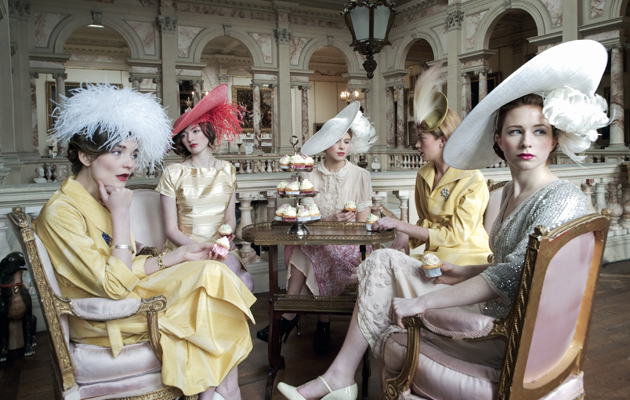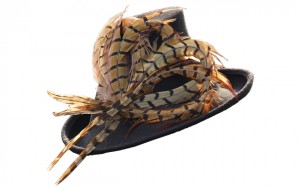Hat-wearing is enjoying a revival, finds Charlotte Mackaness, and feathers are an essential feature of many of these flights of fancy
Celebrated hat maker Yvette Jelfs ruffled feathers while commentating on fashion at Royal Ascot when she told BBC viewers her hat sported the leftovers of a pheasant she’d shot and eaten. “My sinamay hat was decorated with a pheasant head and feathers. For me, it seems a huge shame not to make the most of the entire bird.”
Jelfs, whose pieces have featured wings, breasts and entire birds, breeds yellow and golden Lady Amherst’s pheasants in the Borders. “They have a good life. They drop their feathers after mating and only through death are they used as whole birds,” she explains. “I did a batch of pheasant heads as buttonholes for a wedding party. It may sound a little shocking but they looked amazing. People come to me because they want something different.”
Although beautiful, Jelfs’s pieces are not breaking new ground. “In the 19th century it wasn’t uncommon to see flocks of humming birds on a single hat,” says Sharon Bainbridge from Stockport’s Hat Works museum. “Ladies wore huge hats piled with flowers, foliage, feathers and whole birds – they must have been incredibly heavy. The peak of this fashion for feather was between the 1850s and 1860s when we were importing four to five million birds a year to satisfy demand.
“Alongside the hat makers, a whole other industry existed employing thousands of women in this country and in France as plumassiers,” explains Bainbridge. “These ladies worked plucking the birds and
then treating, dyeing and curling the feathers. The dyes were horribly carcinogenic and as the ladies often put the feathers in their mouths while working, many developed terrible illnesses.
“Fashion moved very fast and every season a different bird would be in vogue. Feathers were a status symbol and so there was a constant quest to display something rarer, more exotic and unusual,” she continues. “Some birds, especially species of birds of paradise, became extinct because of millinery fashion. The RSPB’s roots at the end of the 19th century were as a pressure group to stop the trade.”
The Importation of Plumage (Prohibition) Act was passed in 1921. Typically, politicians were lagging behind style leaders of the time. The threat to rare birds had been limited years before as society ladies started to question the use of such feathers. “Most importantly, in 1906 Queen Alexandra announced she would no longer wear the feathers of wild birds. She was the Kate Middleton of her day and people took their lead from her,” explains Bainbridge.
Today, the Duchess of Cambridge is heading a hat-wearing revival and, in 2012, was named Hat Person of The Year by the Headwear Association. “I would say 50% of my clients mention Kate Middleton when describing the hat they’d like. She has bought several feathered hats from me,” says Amy Money. “The first was a small dish featuring pheasant, coque (cockerel) and goose feathers. Goose feathers are lovely to work with. They are petal-shaped and curl just like ribbon.”
Money lives on a farm where she hand rears guineafowl, turkeys and chickens, so uses many of her own feathers. “People don’t realise how beautiful the feathers can be from everyday, domestic birds,” she says. “The variety of different shapes, colours and textures that you find on a single bird is extraordinary.
“The tail feathers of a cockerel are particularly striking. Sometimes I cut them to leave just a tip, which creates an arrow shape. Turkey and goose are similar to each other. The feathers from the wing make really pretty feather flowers. They are also great to dye as they take up the colour brilliantly,” she adds.
In some cases, Money does little to the feathers. “One of my favourite birds is the Lady Amherst’s pheasant. The tail feathers are more than a metre long and have black and white stripes with a gold tip – a great example of where nature can’t be bettered. However, they are expensive – about £12 a feather.”
Some feathers, says Money, are better to work with than others. “Coque feathers have a thin spine. This makes them easy to manipulate but they are prone to snapping. Pheasant and partridge feathers are oily, which means you have to bleach them before trying to dye them. However, they are resilient in the rain and hold their shape well. Generally speaking, the fluffier the plumage, the more sensitive it is to the wet. Feathers such as guineafowl, ostrich and peacock can split if not kept dry.”
One of Money’s more unusual commissions was from a lady who kept parrots. “I had great fun making a hat for her from wonderful green and red macaw feathers. I love using peacock feathers, too, although I have come across a few older clients who are funny about them because they consider them unlucky.”
London-based milliner Judy Bentinck, who teaches at Central St Martins, has also come across aversion to peacock. “I’d never use the eye because they make many people feel uncomfortable,” she says. “I was asked by the British Museum to produce some hats for its shop but the museum specifically asked me not to use peacock because they have negative connotations in so many cultures.
“A surprising number of people are allergic to feathers,” adds Bentinck. “However, for those without such worries, the great appeal of feathers is their tactile quality. A popular hat in my range is a Twenties-style cap covered in guineafowl feathers. People love to touch and stroke them. One client brought me a bag of feathers she’d collected from her own guineafowl – that personal connection always makes it really special.”
One mother of the bride came to Helen Richardson with something rather too close to her husband’s heart. “He was a keen fisherman who made his own flies. His wife brought me not only his box of spare feathers but also his flies, and asked me to make a hat using them,” recalls Richardson. “It looked wonderful but she didn’t tell her husband and the penny only dropped when she sat down next to him in church.”
Wendy Goode makes feather pins, hats and hatbands in Scotland. “When I started, I’d drive past road kill and pick up the birds,” she confesses. “Now I’ve built up relationships with various keepers so it isn’t so necessary. However, I got rather excited when a swan died locally but it was a great disappointment – the feathers were hard to work with.”
A bird sanctuary in southern England sends Goode owl and hawk feathers but there’s one feather she couldn’t work without. “The greeny-black feathers you find on a cockerel are stunning and so useful. Mallard is also brilliant. The shape makes it great fun and it is also fabulously malleable,” she says.
Couture milliner Will Hedderwick concurs. “Duck has a fabulous iridescence. I like to use the entire wing. It looks incredibly stylish on the side of a hat. A memorable commission was a top hat I made for a friend in LA that was finished with black cockerel feathers with a brilliant greeny-blue sheen. I have also been asked to make a hat using an entire grouse – the first the lady had ever shot. Grouse feathers tend to be earthy and brown – not that spectacular at first glance – but they are useful because they blend well. Grouse also looks smashing with a heathery tweed,” he reveals. “Pheasant is more of a showstopper. The colours of the feathers are amazing and they can be sculpted into various shapes.”
We may never return to the heady hat styles of the Victorian era or the days before the Second World War when hats were everyday attire, but thanks to the “Kate” effect and an interest in vintage fashion, hats are enjoying a revival. “Feathers never go out of mill-inery vogue,” believes Amy Money. “Hats with big brims are particularly fashionable at the moment, which allows all the more scope to experiment with lots of fabulous feathers.”
FEATHERED FRIENDS
There are rules regarding feathers from abroad and from wild birds, but gamebirds and domestic fowl are exempt. Always buy from a reputable source.
Treat feathers before using them to remove insects. Dyeing also helps kill them off.
Store feathers in a dry place with lots of space as once they have been bent into a shape they are hard to straighten.
Small, fluffy feathers, such as guineafowl, are easier to dye than large plumes. The spines of large feathers don’t take up dye, so have to be coloured separately.
HAT-MAKING COURSES
Yvette Jelfs runs courses lasting from 21⁄2 hours (£150) to five days (£1,700) across the country, including in Edinburgh, the Borders and London. Call 020 7706 7632 for details or visit www.yvettejelfs.com.
Helen Richardson, based in Shropshire, offers one- and two-day courses costing £100 or £200, including refreshments and materials. Call 01746 785140 or go to www.helen-richardson.com.
Judy Bentinck runs fascinator classes (£145 including materials and refreshments) and millinery workshops from her studio in central London. Call her on 07966 272469 for details or go to www.judybentinck.com.







